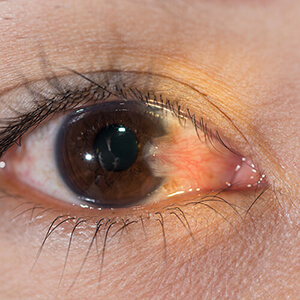Pterygium Surgery
A pterygium is a growth of the conjunctiva, which is the membrane that covers the white part of the eye. A pterygium grows from the white part of the eye onto the cornea, the normally clear window in the front of the eye. This is particularly common if you were exposed to a lot of sun, sand, or wind while you were growing up. You may want to remove a pterygium if it changes your vision, causes significant discomfort, or is constantly red and irritated.
Dr. Lee is very experienced at pterygium excision to remove these growths. He uses the newest surgical techniques to aim for the best cosmetic and functional result possible and has a very low recurrence rate as a result.
Pterygium with Conjunctival Autograft
After removal of the pterygium, a partial thickness patch of tissue from the patient’s own eye is then repositioned to fill the gap left behind. This graft heals into place and provides a barrier to regrowth of the pterygium. Meanwhile, your eye regrows the layers that were used to make the autograft.
This surgery usually takes about 40 minutes, and you will wear a patch for one night. For the first several days after surgery, it is best to avoid very strenuous activities and movements so that the graft seals itself in position. Patients usually take eyedrops for two to three months after to reduce the risk of recurrence.
Pterygium without Autograft
An alternative way to reduce recurrence is for Dr. Lee to inject a small amount of medicine around the excision site. This is sometimes paired with the use of amniotic membrane, a dissolving tissue that reduces inflammation and decreases the risk of recurrence.
This surgical approach is quicker, usually taking about 15 minutes in the operating room. Again, patients will wear a patch for one night and take drops for two to three months afterward. Although Dr. Lee recommends conjunctival autograft for large, aggressive, or recurrent pterygia, this second technique works well for smaller pterygia. At your consultation, he will discuss whether you are a candidate for one or both surgical strategies.
Amniotic Membrane Transplant
Amniotic membrane is a tissue that has anti-inflammatory and pro-healing properties. Dr. Lee performs amniotic membrane transplants for multiple reasons, including pterygium surgery, corneal ulcers, corneal thinning, corneal numbness, or poor corneal healing. In many cases, he can perform this procedure in clinic, while in other cases, this is performed in the operating room.

Phototherapeutic keratectomy (PTK)
The laser is used to smooth the cornea or remove scar tissue. Dr. Lee has performed a large number of these procedures for many different indications.
YAG Laser Capsulotomy
A significant portion of patients develop cloudiness of the membrane that holds the artificial lens implanted during cataract surgery. After the eye has had some time to heal, a laser is used to make a small opening in the membrane to restore clarity of the vision. This laser procedure can be done in the office, usually in a matter of minutes.
Glaucoma Lasers
Dr. Lee performs glaucoma lasers for both types of glaucoma.
